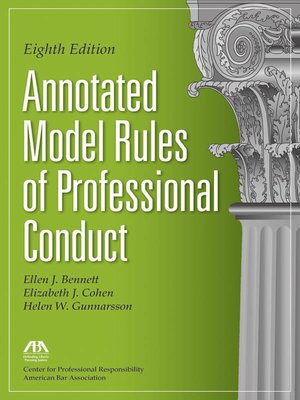
Sign up to save your library
With an OverDrive account, you can save your favorite libraries for at-a-glance information about availability. Find out more about OverDrive accounts.
Find this title in Libby, the library reading app by OverDrive.



Search for a digital library with this title
Title found at these libraries:
| Library Name | Distance |
|---|---|
| Loading... |
An essential resource on lawyer ethics – revised and updated: The Annotated Model Rules of Professional Conduct is the ABA's definitive single-volume resource for information about how courts, disciplinary bodies, and ethics committees apply the lawyer ethics rules.
The Eighth Edition incorporates all of the amendments the ABA has made to the Model Rules of Professional Conduct through February 2015 – including the 2012 and 2013 amendments adopting the recommendations of the ABA Commission on Ethics 20/20 relating to advances in technology, global legal practice, outsourcing, and confidentiality in the context of conflicts checks when lawyers change firms.
Comprehensive and authoritative: Each chapter begins with the rule and its comment followed by a link to charts comparing each state's rule with the Model Rule [NEW with this edition], and then presents a detailed discussion of how the rule has been applied. The book gives citations to thousands of court cases, ethics opinions, law review articles, and internet resources, as well as treatises, the Restatement (3rd) of the Law Governing Lawyers, and the legislative history of the Model Rules.
For all jurisdictions and practice settings: Almost every jurisdiction now bases its ethics rules on the ABA Model Rules of Professional Conduct. And nearly every one has amended its ethics rules in light of the ABA's across-the-board revisions in 2002 and its subsequent amendments relating to confidentiality, corporate representation, and multijurisdictional practice.







